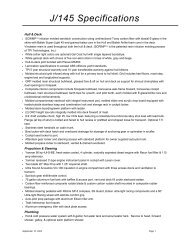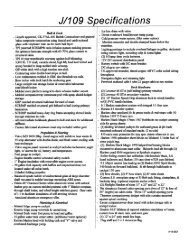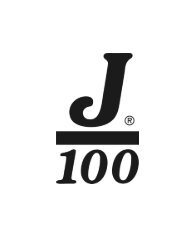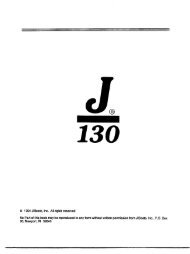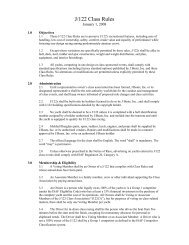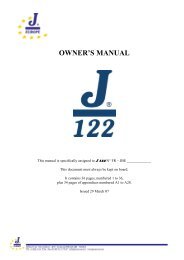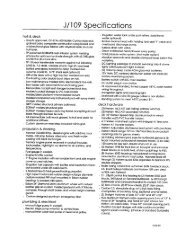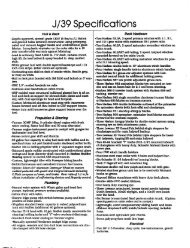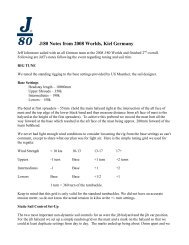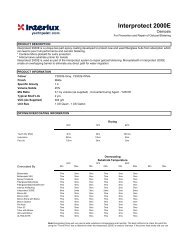J105 Owner Manual 2012.pdf - J/Owners
J105 Owner Manual 2012.pdf - J/Owners
J105 Owner Manual 2012.pdf - J/Owners
Create successful ePaper yourself
Turn your PDF publications into a flip-book with our unique Google optimized e-Paper software.
J/105 <strong>Owner</strong> Guide ...................................................................................................................................................................................................................................................... 49 <br />
Aluminum Spars -‐ are subject to corrosion and fittings should be routinely inspected and replaced <br />
when necessary. Particular problem areas over time can be fasteners around boom vang, boom <br />
and mast ends, and gooseneck attachment brackets. <br />
Booms -‐ often have a shorter life than masts, particularly on race boats that do a lot of windward-leeward<br />
buoy racing in breezy conditions. In some class boats it is common practice to pull the <br />
boom vang hard going upwind (vang-‐sheeting) and then release the boom vang several inches <br />
going downwind. However if one bears away without first releasing the boom vang (from its <br />
vang-‐sheeted position) then most booms will bend under this load. Repeated occurrences will <br />
shorten the life of the boom and could cause breakage. <br />
Rig Cutting Tool -‐ Every sailboat should carry aboard a tool that is capable of cutting through <br />
standing rigging quickly. When a mast does break, the portion that is in the water can easily ram <br />
a hole and potentially sink a boat. You may not have time to unwrap the rigging tape and pull <br />
clevis pins at all the attachment points. The top of the line cutters are hydraulic, which can be <br />
used on wire or rod rigging. For small one designs (ex…J22, J24 & J80), a good hacksaw should <br />
be carried at a minimum. <br />
Other Structure <br />
Bulkhead Tabbing -‐ the primary structural bulkheads of the boat are tabbed both to the hull and to <br />
the deck. This tabbing (or fiberglass tape) should be inspected annually and, especially, after any <br />
groundings or excessive exposure to “hard trailering”. If there is any evidence of gelcoat cracking <br />
or actual tabbing visibly loose or beginning to peel, ensure that a marine surveyor inspects the <br />
boat and recommends adequate remedies to correct potential damage. <br />
Hull-‐to-‐Deck Joint -‐ all modern J/Boats are built with a “glued” PLEXUS (2-‐part elastomer glue) <br />
hull to deck joint. It is an ISO/ABS approved method for hull-‐to-‐deck bonding. This joint should <br />
be inspected at least annually and, in particular, if any leaking is noticed inside the hull. <br />
Sometimes the best check is to use a “non-‐permanent dye” in water to squeeze into the hull/deck <br />
joint and look for “runs” inside the hull. If any leaking is observed, have the hull to deck joint <br />
surveyed and have the surveyor make recommendations for adequate remedies to correct <br />
potential damage. <br />
Chainplate Fittings -‐ Both port and starboard chainplates and the bow and stern chainplates <br />
should be checked at least annually. Look for leaks where they intersect the deck. <br />
Bow Sprit System -‐ the sprit system is a combination of a carbon tube, pulley system and an <br />
integral bulkhead/ bow support. The system can easily be damaged, particularly when struck <br />
laterally or vertically at the end of the pole with any force (e.g. when rounding marks hitting <br />
sterns, hitting metal buoys, or burying the bow in steep seas under full force of the asymmetric <br />
spinnaker too many times). Regularly inspect the sprit for excessive wear where the sprit <br />
intersects the outer bearing at full extension. <br />
Deck Hardware <br />
Lifelines & Lifeline Fittings -‐ should be replaced at least every 10 years or at the first sign of <br />
corrosion or damage to the wire strands, swages or turnbuckles. Many older boats have white <br />
vinyl coated lifelines, which are no longer allowed by ORC Offshore regulations, as the vinyl can <br />
disguise ongoing corrosion or damage to the wire. These should be replaced using appropriate <br />
wire type and diameter immediately.



